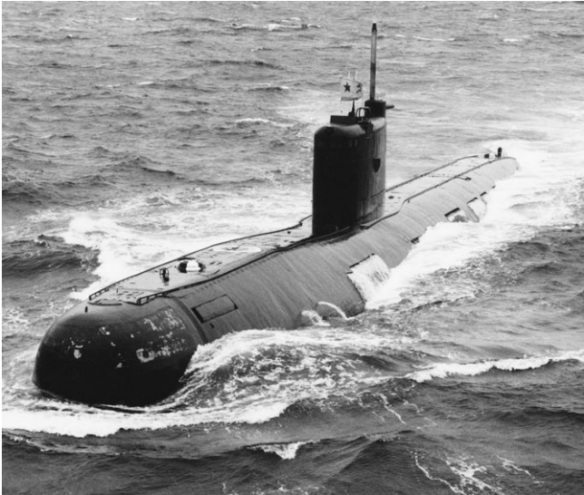The simplistic lines of the Project 941B/Tango are evident in this view. The Tango was intended as the successor to the Foxtrot class, but, in the event, few were built. The Tango’s principal advantage over her predecessor was increased submerged endurance.
The Project 633/Romeo had the same sonars as the larger Foxtrot. The Romeo’s sail was distinguished by the “top hat” extension that housed the submarine’s periscopes. The massive Romeo construction program was cut back in the USSR because of the shift of emphasis to nuclear propulsion and long-range submarines.
The success of Project 641/Foxtrot, led to several cruise missile (SSGN) variants being proposed. In 1956-1957 preliminary designs were developed at TsKB-18 for Project 649, a more advanced diesel-electric submarine with a surface displacement of some 2,560 tons, a submerged dis placement of 3,460 tons, and an underwater speed up to 20 knots. The project was not pursued.
Instead, from 1965 a TsKB-18 team under Yuri Kormilitsin developed Project 641B (NATO Tango). This was a major improvement of the Foxtrot design with respect to hull form and battery capacity, the latter providing an increase in submerged endurance. Also, the sonar was linked directly to the torpedo fire control system, enabling more rapid handling of firing solutions and the automatic transmission of data to torpedoes before firing. Eighteen submarines of this long-range design were delivered from 1973 to 1982 by the Krasnoye Sormovo shipyard in Gor’kiy (now Nizhny Novgorod). Construction of these submarines, in turn, was halted with development of the improved Project 877 (NATO Kilo) design.
Meanwhile, with the completion of the truncated Project 613/Whiskey program-the last submarine being delivered in 1958-work was under way on a successor medium-range submarine, Project 633 (NATO Romeo). Design work had begun at SKB-112 (Lazurit) in 1954 under chief designers Z. A. Deribin and, after 1959, A. I. Noarov. The new design had enhanced armament, sensors, and performance over Project 613.
The number of bow torpedo tubes was increased to six, in addition to the two stern tubes, while sonar, habitability, and food storage were improved, the last increasing practical endurance from 30 days for the Whiskey to 60 days for the Romeo. The latter submarine was viewed as the ultimate undersea craft of its type by the Soviet Navy’s leadership with preliminary plans being made for the production of 560 ships!
The first Project 633/Romeo, the S-350, was laid down on 22 October 1957 at the Krasnoye Sormovo shipyard in Gor’kiy, which had been the lead yard for the Whiskey class. The submarine was delivered to the Navy in December 1959 with a total of 20 units being built through 1962. The early cancellation of large-scale production and the subsequent transfer of 15 of these ships to other countries reflected the Soviet Navy’s emphasis on nuclear propulsion and long-range conventional undersea craft. The recipients were Algeria (2), Bulgaria (4), Egypt (6), and Syria (3), with the Egyptian units being transferred upon completion.
China was given plans and documentation for Project 633/Romeo and initiated mass production construction of these submarines at four ship yards. According to Chinese sources, slightly more than 160 units were completed in China from 1962 to 1987, which would make this the second largest class of under sea craft constructed after World War II. 19 (Western sources place Chinese production of the Romeo at 92 units, completed between 1960 and 1984; eight of those were transferred to Egypt (4) and North Korea (4).
One Soviet unit of this class, the S-350, sank in 1962 at the naval base of Polyarnyy on the Kola Peninsula as a result of a torpedo explosion in the nearby submarine B-37. The S-350 was salvaged, repaired, and placed back in service in 1966.
In 1956 work began at SKB-112 on the more advanced Project 654, a medium-range submarine with a surface displacement of some 1,600 tons. This was the first Soviet submarine design based on the high-speed USS Albacore (AGSS 569). Construction of the lead submarine was begun at the Krasnoye Sormovo yard, but soon halted. This marked the end of the development and construction of medium-range submarines in the USSR.
